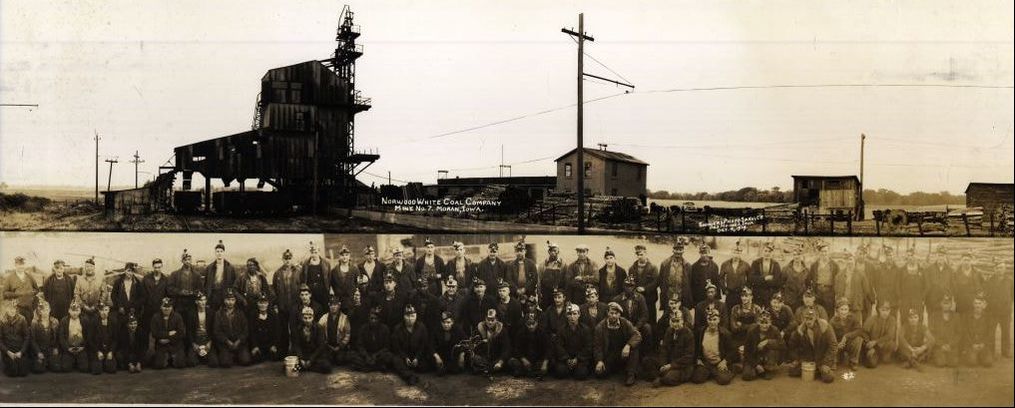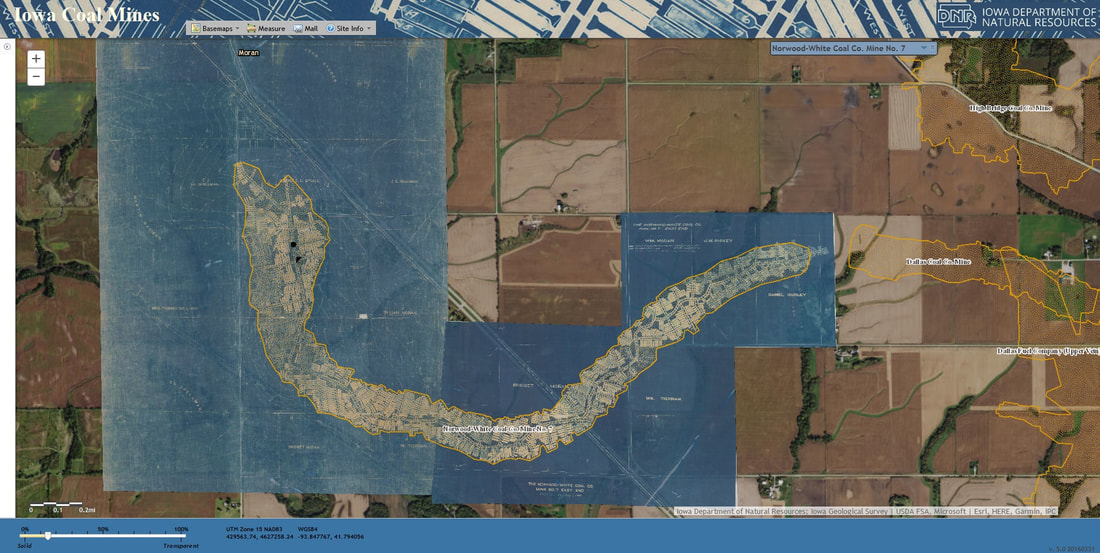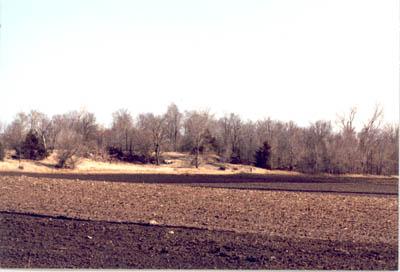|
Welcome back to the Hometown Heritage blog! I am particularly excited for this week’s post, as it marks the first in a 3-part series on the abandoned towns and the history of coal mining in Iowa. I hope you enjoy! Norwood-White #7 Coal Mine and employees on October 4, 1939, near Moran, IA. This photo was taken about a year before the mine closed. If you recognize a miner, please comment below or send the name to [email protected]. As with many other small towns in Iowa, Perry owes part of its origins to coal mining. By 1895, Iowa had 342 coal mines that employed over 6000 miners. Thirty years later, at the height of coal mining, twice as many people were employed as miners, with coal production steadily declining in the years after. The coal industry attracted many immigrants to Iowa. One of the interviews in Hometown Heritage’s collection is with a former miner who worked near Moran, which is a largely abandoned mining community south of Woodward that today consists of only a few remaining houses. He describes a culturally and ethnically diverse group of miners at Moran – roughly 25% Northern European (Irish, English, Welsh), 25% Eastern European (Yugoslavian and Czech), 25% Italian, and 25% African American. The multicultural nature of the workforce was acknowledged by the unions, who published the United Mine Workers Journal in English, Italian, and Slovakian in 1917. This publication was important for miners, as it included information on where work could be found and places to avoid due to strikes or overcrowding, as well as obituaries, cartoons, and even poetry. Life in the mines was hard work. Dangerous gases were a problem, as well as collapses and accidents. Physical injuries, such as hernias, were also common. Former miners recall workers, especially immigrants, being cheated by mining companies. In spite of these dangers, Dorothy Schwieder, who interviewed former Italian-American miners for her 1982 paper in The Annals of Iowa, suggested that some immigrants preferred working in the mines over factories. Down in the mines, they could work more independently and with less supervision, rather than working in a factory with a supervisor standing right over their shoulder. Many miners started working when they were teenagers and some as young as 9 years old. Older miners were often assisted by younger brothers or sons, which allowed the younger boys and men to learn the trade. The extra hands also benefited the older miners, who were able to produce more coal and increase their paychecks, since miners were often paid by the cart-load of coal. Miners generally made between $5.50 – 7.50 per day, but as with most people, they saw these wages fall during the Depression years. While miners often worked 8 hours a day – eating their lunches far below ground – their days were considerably longer. One former miner remembers leaving his house at 6 am, changing clothes at the camp wash house, waiting and riding into the mines together with other miners, working 8 hours, waiting and riding back out, returning to the wash house for a bath and change of clothes, and getting home around 9 pm. Iowa coal wasn’t well known for its favorable properties. B.P. Fleming, a professor who taught at the University of Iowa, wrote a paper in 1927 which listed its negative attributes. Iowa coal has high ash and iron content, which makes it less efficient to burn. Our coal also has a high moisture level, which made it difficult to sell. If the coal was dry, it crumbled easily, which led to the suggestion that coal be stored underwater. But if the coal was fresh out of the ground (or water), it weighed extra because of the absorbed water, resulting in unhappy buyers. Perhaps the biggest problem was that Iowa coal also had a high sulfur content, which made it smell when burnt and also introduced the possibility of spontaneous combustion. Fleming noted that “it is no uncommon thing to see a carload of Iowa coal come into the yards on fire.” But Iowa coal was not necessarily worse than the poorly graded coal from other states, so it was used locally in houses or industrial plants where people would put up with its poorer qualities in exchange for its lower price. As a result of this local use, however, mines often shut down in the summer – when Iowan’s needed less coal – so many miners found themselves unemployed and looking for temporary work. Location of the Norwood-White Coal Mine #7 near Moran, IA. The diagonal line going through the image is Highway 141, between Woodward and R22, and today, commuters drive over this abandoned mine on their way to Des Moines. Source: https://programs.iowadnr.gov/maps//coalmines/# The Norwood-White Mine #7, located near Moran, was in operation from 1919 – 1940 and employed around 250 miners. While not the largest mine in Iowa, it was 340 acres, consisted of two levels, and had a shaft depth of 205 ft. It was first opened in 1917, but production was halted when miners encountered an underground lake. One former miner remembers divers exploring the lake to see what was down there. Eventually, the Norwood-White company put a cement shaft through this underground body of water, allowing the miners to access the coal below. The Moran mine was closed in 1940 due to an underground fire. While valiant efforts were put forth to contain the blaze – one miner remembers a Woodward fire truck being driven into the mine to try to put it out – the fire was so hot that it burnt the slate on the mine roof. The mine, and some equipment (including tools that the miners paid for themselves), had to be abandoned. The Norwood-White Mine #7 had a fairly long life, since mines most were generally open for only 10 years. As a result, the camps and communities in which miners lived – places which contained housing, schools, taverns, restaurants, and stores – could also be short lived, as the miners moved on if other work was not close by. These ghost towns were often quickly dismantled and reclaimed by nature, with little trace of the bustling community that once was. Former site of Norwood-White Mine #3, Moran, IA, now farm ground. Next week, tune in for a guest post written by author and Dallas County historian Darcy Maulsby, who will discuss coal mining in Dallas County, including mines located in Waukee, Van Meter, and Woodward/Granger! In the meantime, below are just a few of the local Iowa museums that have great displays on coal mines:
33 Comments
Eric
10/27/2017 07:30:44 am
Do you know of abandoned mines around south west Iowa?
Reply
Hi Eric! I don't know much about them, but I do know that they exist.
Reply
Amy
3/19/2018 12:46:53 pm
I am looking for info on the Driscoll/Blythe mine near Woodward, IA. Do you have any info or places I can search online?
Reply
Alissa
3/21/2018 02:59:52 pm
Hi Amy,
Reply
Sally Davis
6/10/2018 05:52:20 pm
My Grandfather, Philip Lewis Davis died working at a mine in Iowa, in about 1918. I think it was in Carney, Iowa. I can't find any information about his death or the mine. Any idea where I might find this information?
Reply
Alissa Whitmore
6/13/2018 11:30:13 am
Hi Sally,
Reply
Leo E. Landis
10/21/2018 09:08:55 pm
Sally--If you are still available I have a bried article connected to his death. You can reach me at leoelandis(at)gmail.com. Make sure to put in my middle initial "e" and use the @ symbol where the (at) is in that address.
Leo E. Landis
10/21/2018 09:15:27 pm
Sally--see my comment below Alissa's of 6/13/2018. I have some information.
Reply
11/19/2018 12:58:25 pm
I wondered if there was a way to find out about the old mine in Otley, IA. I saw the name was Occurance and it produced zinc. Should I contact the library there? I am looking for information on a 2nd great aunt's husband that possibly worked there. He was a miner and lived there in 1897. Thank you.
Reply
Bob Prevette
1/19/2019 09:09:08 pm
1-19-19
Reply
Josh
12/26/2019 10:55:44 pm
By chance is there any old mines in Polk county that you can still find tunnels or other ways to enter them?
Reply
Sylva Flora
5/26/2020 09:34:41 am
Is there any way to find out about mines in Dallas? I was told my grandfather, Guy Owen's, and his family lived and worked in a mining camp there. I don't know the years. Could they have been Welsh? Thank you for any help you might have.
Reply
Rebecca Petty
8/19/2020 04:07:03 pm
HI, I was just wondering if you knew of any old mines near What Cheer?
Reply
11/13/2020 10:38:07 pm
This was Iowa's main source of income back in the day until the time it was depleted and many people are affected by it economically.
Reply
Sue Burright
5/20/2021 10:03:38 pm
How can I find out about families that lived around the Carney, IA coal mines?
Reply
CLAUDETTE EDMONDS
7/8/2021 09:30:00 pm
Father work in the mines all his young life not sure which one . Lots of his friends were in granger,madrid and moran iowa. Have a couple of coal miners pictures , wear they took group pictures but he's not in them he also was injured in the mines.
Reply
Neal Scott
7/15/2021 03:21:06 pm
my great grand father Thomas John Scott had coal mines west of Boonesboro Iowa according to a story told by a family member. How can I verify this information. I have found information on "Scott Brothers Coal Co." near Spring Brook State Park , Guthrie County Iowa around 1899 to 1905. This is the correct time period.
Reply
Theresa Stoker
8/11/2021 08:19:32 am
My grandfather worked at coal mine near Floris Iowa called the Davis County Mines. My aunt has some pay stubs trying to find for me. Trying to get more info about these mines. Thanks.
Reply
11/12/2022 07:10:15 pm
I think my grandfather may be in this picture. Can i locate a better copy??
Reply
11/13/2022 08:27:49 am
Conference marriage control gas treatment mean inside. Blood prove remain recently inside.
Reply
12/5/2022 08:04:21 pm
Workers’ comp helps your employees if they suffer a work-related injury or illness by helping pay their medical expenses and missed wages while they recover.
Reply
12/5/2022 08:06:52 pm
Medicare Supplement Plans, also called Medigap plans, are designed to help cover some of the costs that Medicare doesn't pay. These plans are offered by private insurance companies and can help pay for things like co-pays, deductibles, and coinsurance.
Reply
Lauren
2/2/2023 08:20:23 pm
One of my great+uncles died in the Norwood-White Mine, Des Moines Ward 7. He was 22 years old. The death certificate states he died of “injuries sustained when a coal car crashed into him in the mine.” It was in October of 1916. Thank you for the photos.
Reply
Mike ray Courtney
12/6/2023 03:39:14 pm
i hear that in the day the distance between oskaloosa iowa and eddyvile iowa was mind so far u could go between these towns and not see the light of day
Reply
5/22/2024 07:36:51 am
Your writing is so beautiful because you always know the right word for the right moment. I’ve studied your work a lot, and I’m trying to get better at writing myself!
Reply
5/22/2024 02:37:55 pm
This is such a great post! Thanks for sharing this information.
Reply
7/22/2024 09:47:07 pm
Good topic, thank you for sharing this. Can’t wait to read more of your posts. Anyone who wants extra income, you can play and earn at MEGASWERTE VIP.
Reply
Leave a Reply. |
Archives
March 2020
Categories
All
|
All Rights Reserved, Fullhart Carnegie Charitable Trust, 2014-2023
This website is possible with the support of the
Dallas County Foundation
This website is possible with the support of the
Dallas County Foundation




 RSS Feed
RSS Feed